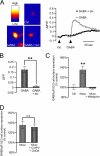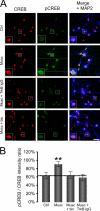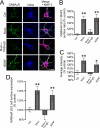Positive feedback regulation between gamma-aminobutyric acid type A (GABA(A)) receptor signaling and brain-derived neurotrophic factor (BDNF) release in developing neurons
- PMID: 21474450
- PMCID: PMC3122223
- DOI: 10.1074/jbc.M110.201582
Positive feedback regulation between gamma-aminobutyric acid type A (GABA(A)) receptor signaling and brain-derived neurotrophic factor (BDNF) release in developing neurons
Abstract
During the early development of the nervous system, γ-aminobutyric acid (GABA) type A receptor (GABA(A)R)-mediated signaling parallels the neurotrophin/tropomyosin-related kinase (Trk)-dependent signaling in controlling a number of processes from cell proliferation and migration, via dendritic and axonal outgrowth, to synapse formation and plasticity. Here we present the first evidence that these two signaling systems regulate each other through a complex positive feedback mechanism. We first demonstrate that GABA(A)R activation leads to an increase in the cell surface expression of these receptors in cultured embryonic cerebrocortical neurons, specifically at the stage when this activity causes depolarization of the plasma membrane and Ca(2+) influx through L-type voltage-gated Ca(2+) channels. We further demonstrate that GABA(A)R activity triggers release of the brain-derived neurotrophic factor (BDNF), which, in turn by activating TrkB receptors, mediates the observed increase in cell surface expression of GABA(A)Rs. This BDNF/TrkB-dependent increase in surface levels of GABA(A)Rs requires the activity of phosphoinositide 3-kinase (PI3K) and protein kinase C (PKC) and does not involve the extracellular signal-regulated kinase (ERK) 1/2 activity. The increase in GABA(A)R surface levels occurs due to an inhibition of the receptor endocytosis by BDNF, whereas the receptor reinsertion into the plasma membrane remains unaltered. Thus, GABA(A)R activity is a potent regulator of the BDNF release during neuronal development, and at the same time, it is strongly enhanced by the activity of the BDNF/TrkB/PI3K/PKC signaling pathway.
Figures









Similar articles
-
Excitatory actions of GABA increase BDNF expression via a MAPK-CREB-dependent mechanism--a positive feedback circuit in developing neurons.J Neurophysiol. 2002 Aug;88(2):1005-15. doi: 10.1152/jn.2002.88.2.1005. J Neurophysiol. 2002. PMID: 12163549
-
Rapid brain-derived neurotrophic factor-dependent sequestration of amygdala and hippocampal GABA(A) receptors via different tyrosine receptor kinase B-mediated phosphorylation pathways.Neuroscience. 2011 Mar 10;176:72-85. doi: 10.1016/j.neuroscience.2010.12.041. Epub 2010 Dec 31. Neuroscience. 2011. PMID: 21195749 Free PMC article.
-
Depolarizing, inhibitory GABA type A receptor activity regulates GABAergic synapse plasticity via ERK and BDNF signaling.Neuropharmacology. 2018 Jan;128:324-339. doi: 10.1016/j.neuropharm.2017.10.022. Epub 2017 Oct 23. Neuropharmacology. 2018. PMID: 29074304 Free PMC article.
-
BDNF-induced local protein synthesis and synaptic plasticity.Neuropharmacology. 2014 Jan;76 Pt C:639-56. doi: 10.1016/j.neuropharm.2013.04.005. Epub 2013 Apr 16. Neuropharmacology. 2014. PMID: 23602987 Review.
-
Regulation of TrkB cell surface expression-a mechanism for modulation of neuronal responsiveness to brain-derived neurotrophic factor.Cell Tissue Res. 2020 Oct;382(1):5-14. doi: 10.1007/s00441-020-03224-7. Epub 2020 Jun 15. Cell Tissue Res. 2020. PMID: 32556728 Free PMC article. Review.
Cited by
-
The reduced cochlear output and the failure to adapt the central auditory response causes tinnitus in noise exposed rats.PLoS One. 2013;8(3):e57247. doi: 10.1371/journal.pone.0057247. Epub 2013 Mar 13. PLoS One. 2013. PMID: 23516401 Free PMC article.
-
Baclofen modulates the expression and release of neurotrophins in schwann-like adipose stem cells.J Mol Neurosci. 2013 Feb;49(2):233-43. doi: 10.1007/s12031-012-9813-6. Epub 2012 May 31. J Mol Neurosci. 2013. PMID: 22648510
-
L-type Calcium Channel Cav1.2 Is Required for Maintenance of Auditory Brainstem Nuclei.J Biol Chem. 2015 Sep 25;290(39):23692-710. doi: 10.1074/jbc.M115.672675. Epub 2015 Aug 4. J Biol Chem. 2015. PMID: 26242732 Free PMC article.
-
Combination of Chemical and Neurotrophin Stimulation Modulates Neurotransmitter Receptor Expression and Activity in Transdifferentiating Human Adipose Stromal Cells.Stem Cell Rev Rep. 2019 Dec;15(6):851-863. doi: 10.1007/s12015-019-09915-1. Stem Cell Rev Rep. 2019. PMID: 31529274
-
Reciprocal Regulation of KCC2 Trafficking and Synaptic Activity.Front Cell Neurosci. 2019 Feb 20;13:48. doi: 10.3389/fncel.2019.00048. eCollection 2019. Front Cell Neurosci. 2019. PMID: 30842727 Free PMC article. Review.
References
-
- Farrant M., Kaila K. (2007) Prog. Brain Res. 160, 59–87 - PubMed
-
- Whiting P. J., Bonnert T. P., McKernan R. M., Farrar S., Le Bourdellès B., Heavens R. P., Smith D. W., Hewson L., Rigby M. R., Sirinathsinghji D. J., Thompson S. A., Wafford K. A. (1999) Ann. N.Y. Acad. Sci. 868, 645–653 - PubMed
-
- LoTurco J. J., Owens D. F., Heath M. J., Davis M. B., Kriegstein A. R. (1995) Neuron 15, 1287–1298 - PubMed
Publication types
MeSH terms
Substances
Grants and funding
LinkOut - more resources
Full Text Sources
Miscellaneous

